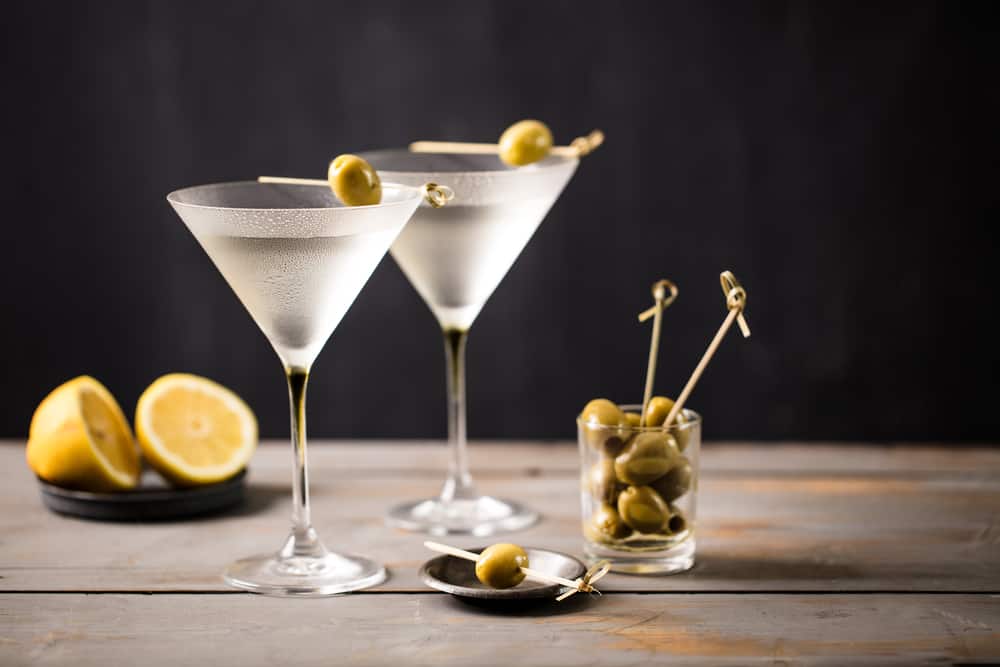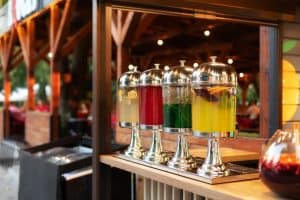
Generally, a Martini is mixed with vermouth and gin and garnished with an olive. Quite simple, very elegant, and a true classic in the cocktail world. But the Martini also has several variations, which can make your head spin before you’ve even had a few.
You may have heard someone order a ‘wet’ Martini and wonder, what is it?
The wet Martini has a bit of an ironic name—it contains more (dry) vermouth than a dry Martini. A wet Martini changes the ratios of the ingredients, usually in a two-to-one fashion: two parts gin to one part vermouth. This delivers a sweeter-tasting Martini, primarily when you use a sweet Italian (or French) vermouth.
We’ll look at how we arrived at both dry and wet Martinis, discuss the wet Martini in a bit more detail and look at some recipes. After that, we’ll dive into the ingredients and look at what vermouth and gin are.
What Is a Wet Martini?

The customary proportion for a dry Martini is roughly six parts gin combined with one part of vermouth. While the exact origins of the Martini are unknown, the present version originates from around 1905, evolving from the Marguerite, when recipes began to include dry gin and dry vermouth.
The star of our article is, of course, the wet Martini. The best recipe we could find calls for vodka instead of gin, but you can substitute the vodka for gin if you like. The recipe is called a Reverse Martini.
If you want an especially wet Martini, replace dry gin with Old Tom gin to get even more sweetness out of your wet Martini.
However, we’d recommend breaking the selected vermouth’s sweetness with a dry gin to keep the balance (otherwise, it might taste like drinking liquid sugar with an alcoholic kick).
To make your wet or Starlight Reverse Martini, you will need the following:
- 1 oz. of vodka—anything you have in the cupboard will do, but try to go for the best you can afford.
- 1 3/4 oz. of sweet vermouth such as Dolin Blanc Vermouth de Chambéry (be careful, this one packs a heavily sweet punch because it contains 130 grams of sugar per liter or 4.6 ounces to 2.1 pints)
- 1 bar spoon-full of Luxardo maraschino cherry liqueur
- Cherry for the garnish
To take another wet approach, you can work on a ratio of 2:1, with two parts of gin to one part of sweet vermouth.
Martini Ingredients

A Martini is made of two essential ingredients: vermouth and gin. Let’s unpack these ingredients below to learn more about them and their role in a Martini.
Vermouth
In its most basic form, vermouth is an aromatized and fortified wine spiked with brandy and infused with spices, herbs, and botanicals and sweetened. It was used as a medicinal drink and moved on to become a famous aperitif.
Historically, vermouth came in two variants: sweet and red (rosso) which originated in Italy. Then, there’s also white or blanc (French) or bianco (Italian) vermouth, which is sweeter and richer than dry vermouth.
Dry vermouth comes from France and contains wormwood (Artemisia absinthium), one of the ingredients in absinthe.
Vermouth does not last long once you open the bottle, so keep it in the fridge to prolong its life. If you don’t mix cocktails regularly, it may be better to opt for half bottles to prevent your vermouth from turning into something undrinkable.
Traditionally dry vermouth is used for a Martini, and the other, gin, which we will look at next.
Gin
Gin originates from the Netherlands, although it has a reputation for being the quintessential English alcohol. During the Dutch War of Independence in the seventeenth century, the English discovered the Dutch version, genever, and took it back to England.
Juniper berries feature prominently in gin distillation and provide a distinct taste. Both the EU and USA have their own rules and regulations for what may be called gin—both make substantial reference to the juniper berry’s taste being the dominant ingredient.
Other ingredients include ‘botanicals’: roots, berries, seeds, herbs, and fruits. Flowers can also fall under this category.
London Dry Gin is the predominant style of gin and is also used in wet and dry Martini, and you can read more about other styles of gin here.
If you want a proper ‘East-meets-West’ wet or dry Martini, there is a stunning Japanese gin produced by House of Suntory called Roku gin—go and look for some pleasant ingredient surprises and perhaps add this unique gin to your shopping or wish list.
Wet Martini vs. Dry Martini
You may ask yourself, what is the difference between a wet and a dry Martini? Essentially, it has to do with the sweetness or lack thereof.
Wet Martinis are sweet, and dry Martinis are not. As simple as that.
But let’s delve a bit into the history and understand how we arrived at these two versions.
Some Martini History
The first version of a Martini is found in Jerry Thomas’s book ‘Fancy Gin Cocktail’, which lacks the vermouth; it calls for gum syrup and one or two dashes of Curaçao. From here, it evolved into the Martinez and Marguerite cocktails, according to Christopher Menning’s article:
- The Martinez is a rather sweet or ‘wet’ recipe: 2 ounces of sweet/Italian vermouth is mixed with a dash of bitters, two dashes of one ounce of Old Tom gin.
- The Marguerite cocktail reverses everything—Plymouth dry gin is combined with dry vermouth in a ratio of two parts gin to one part dry vermouth. The Marguerite is essentially the forerunner of the classic dry Martini.
Conclusion
The wet and dry Martini are opposites—where the dry Martini calls for very little vermouth, the wet Martini requires more vermouth and preferably a sweet type to make it ‘wet’. Both types are equally delicious and show the adaptability of a classic drink that has evolved over the years.
Whichever you prefer, enjoy it and use the best ingredients you possibly can to ensure success. There are, of course, many other variations on the Martini theme; if you’d like to try them, look at this article.








